Signalian
PDF THINK TANK: CONSULTANT

- Joined
- Aug 18, 2015
- Messages
- 10,608
- Reaction score
- 305
- Country
- Location
The events that unfolded in the 1971 War are largely propagated negatively against Pakistan Army, leaving out the Indian involvement and Mukti Bahini atrocities. This piece sheds light on how Indian state-sponsored terrorism played a role in East Pakistan’s dismemberment.
The war of 1965 effected a change in India’s Pakistan strategy, which essentially evolved around a three-pronged offensive on ideological, economic, and military fronts. When the strategy did not succeed, Indian Government resorted to state sponsoring of terrorism inside East Pakistan through the creation of various terrorist organisations like MuktiBahini etc., and infiltrating the political set up in order to exploit the internal socio-political weaknesses. As these efforts also could not deliver the desired results, in April 1971, Indian Prime Minister Indira Gandhi ordered Indian Army to launch an attack on East Pakistan. General Manekshaw, Indian Army Chief; however, convinced her to delay the Indian offensive. According to him, Indian Army was not ready for the offensive and needed time for preparation. Thus, 8-9 months were available to Indian Army to prepare for war and her intelligence organisations had more time to massively enhance state sponsoring of terrorism and furthering the efforts to exploit the internal fissures in support of the impending attack on East Pakistan.

Through a planned and concerted effort, India was thus able to further exploit the internal fissures and managed to generate an extremely negative socio-political environment, which also exacerbated the existing internal weaknesses. After almost nine months of preparations, on December 3, 1971, Indian Government declared an open war against Pakistan and launched its army, navy and, air force offensive in East Pakistan. Simultaneously, war also started on the West Pakistan borders. On December 4, 1971, Pakistan’s Deputy Prime Minister designate and Minister for Foreign Affairs, Mr. Zulfiqar Ali Bhutto, tried to present Pakistan’s case against India in the United Nations Security Council, but having failed to elicit any support, tore the Polish Resolution and boycotted the session.
In such an international environment and having been stripped completely off its supplies, communications and other material resources, a handful of Pakistan Army’s daring, selfless, and determined officers and men continued their endeavours in the defense of their country.
During and after the war, a vicious propaganda campaign was initiated against the Pakistan Army in which it was falsely accused of committing atrocities against the local population. Amongst other aspects, deliberate efforts were undertaken to hide the atrocities committed by Indian Army and various Indian sponsored terrorist groups including Mukti Bahini. These malicious claims have since been proven wrong by various scholars of international repute as well as local Bengali scholars themselves.
In a similar context, a figure of 93,000 Prisoners of War was concocted simply to defame and demoralize Pakistan Army. The total strength of the Pakistani prisoners in Indian camps was not more than 40,000. In this, about 30,000 to 32,000 belonged to Pakistan Army, about 5,000-6,000 were from the Civil Armed Forces, i.e., three Scouts and four Rangers wings, two Mujahid battalions, a small number of Air Force, Naval and Police elements, and a very few civilians.
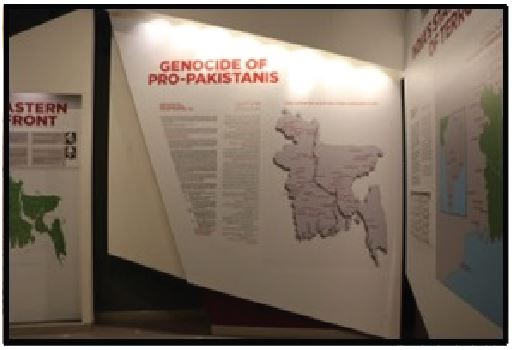
Map of Location of Terrorist Training Camps in India
1971 War Gallery, Army Museum Lahore
1971 is the most complicated and baffling event of our war history. The war was fought in pockets, having many angles and truths to it. In the 1971 War Gallery’s thematic display, it is represented by angular volumes, jarring shapes, and overcast shadows symbolising times of political confusion, crossroads, and overwhelming pressures.
We decided to highlight the terrorism sponsored by India as a state, therefore extensive research was carried out by Brigadier Sufyan, me, and Syeda Aamna Nadeem. We went through a large number of books written by Indian and Bengali authors, especially the retired officers. With the help of information and data gathered from these books, we were able to create two maps:
▪ Map of location of terrorist training camps in India.
▪ Cities where pro-Pakistani non-Bengalis were massacred in 1971.
Perpetration of India’s state-sponsored terrorism during 1971 in East Pakistan through the application of her defense forces and intelligence agencies is a well recorded historical fact. To sponsor state terrorism, a Control Headquarters was raised in Indian Army’s Eastern Command at Calcutta under the supervision of an Indian Army Major General. Six training centers/sectors were established, each commanded by a Brigadier from Indian Army, to organize, train and equip the terrorists for perpetration of acts of terror in East Pakistan.
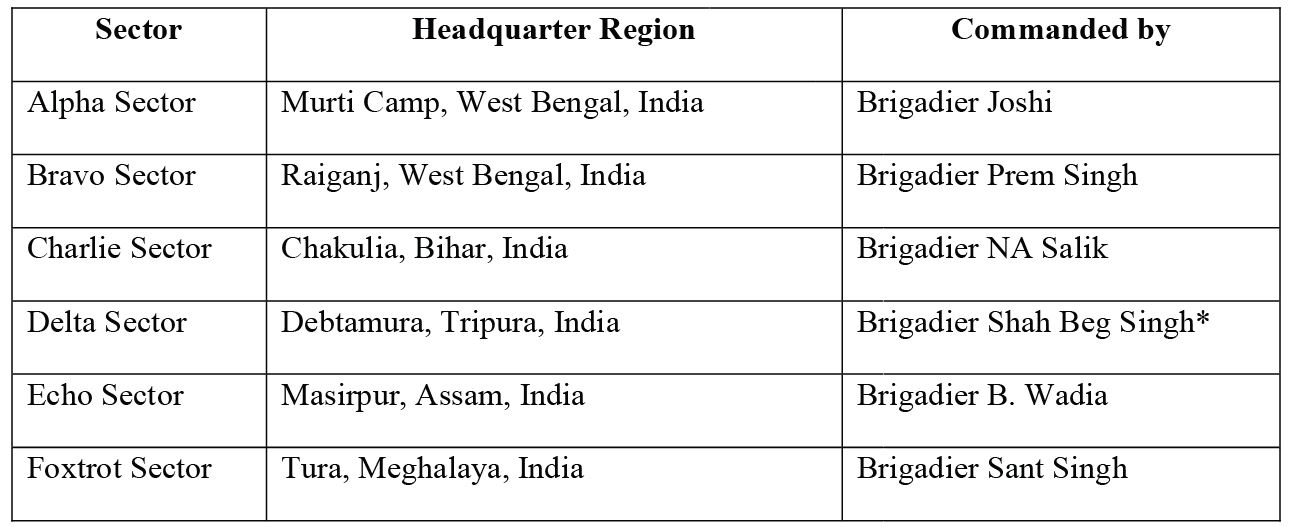
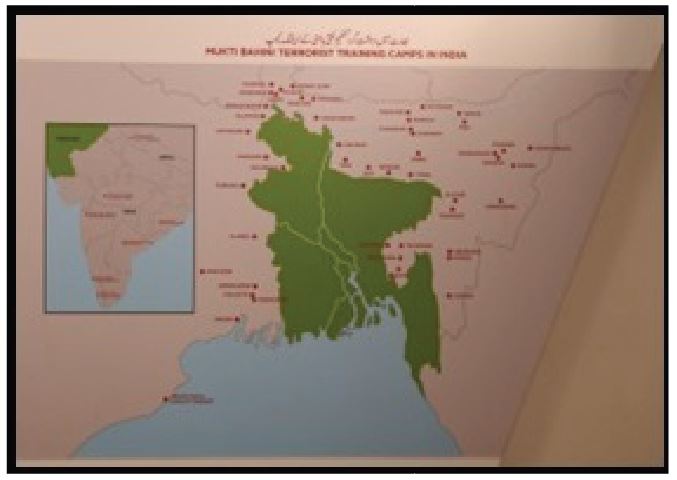
Each sector was organized into a number of terrorist training camps, comprising 500 men battalions. Over 100 such terrorist training camps were established where a total of over 100,000 terrorists were trained.
Around 800 officers were trained at regular Indian Army training institutions including Indian Military Academy, Dehradun. At Cochin and Plassey, over 600 terrorists were also given training to carryout terrorist activities at various ports in East Pakistan.
In the majority of cases, serving Indian Army officers accompanied the terrorists in civilian clothes inside East Pakistan and carried out acts of terrorism which resulted in deaths of tens of thousands of innocent men, women and children.
Cities where Pro-Pakistani, Non-Bengalis were Massacred in 1971
The massacre of non-Bengalis, especially pro-Pakistani non-Bengalis by Mukti Bahini terrorists has been mentioned on a map. This map shows the cities where the genocide took place. References about the role played by India, statements of internationally
renowned writers, Bengali scholars, and Indian leaders have also been displayed.
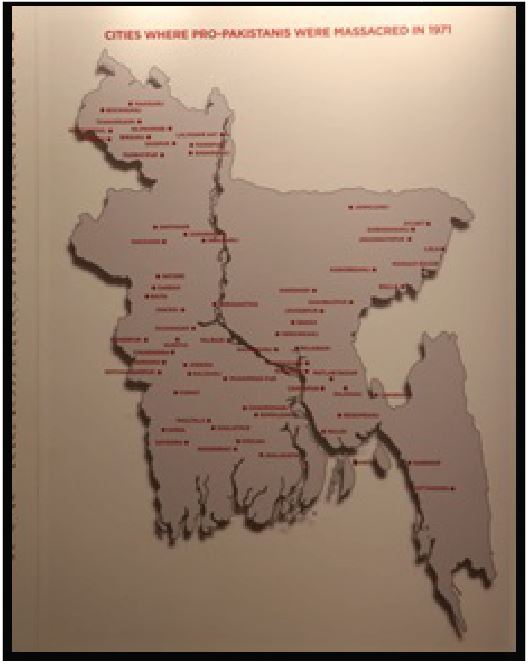
“The Army authorities in East Pakistan have never claimed that their efforts to quell the secessionists was an easy task. Nor have they ever said that during their drive to save the integrity of Pakistan, no innocent civilians, were killed in the cross fire. But, the claim of wanton killing by the army, far less the allegation of systematic genocide by them, is simply untenable”.
–Dr. Abdul Mu’min Chowdhury,
Behind the Myth of Three Million
"The Pakistan soldiers in the East during 1971 was suppressing a rebellion, and not in occupation of a foreign country. Sheikh Mujib's wild figure of three million Bengalis killed during those ten terrible months is at least 20 times too high, if not 50 or 60. And what of all the killing that the Bengalis did whenever they had a chance?"
–Peter Gill, Pakistan Holds Together,
Daily Telegraph, London, April 16, 1973.
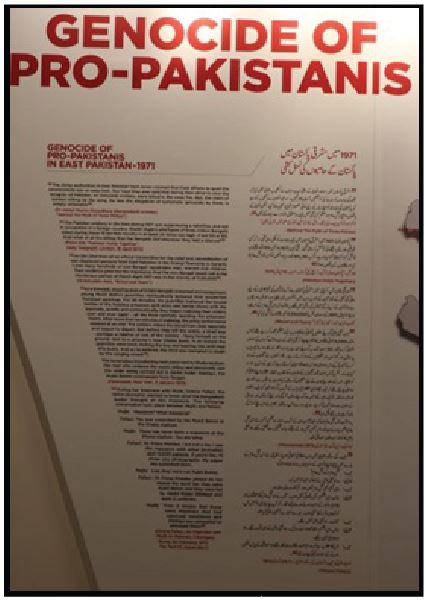
“As the Chairman of an official Committee for the relief and rehabilitation of war-displaced persons from East Pakistan in the Orangi Township in Karachi, I met many hundreds of non-Bengali repatriates–men, women, and children. Their evidence gave me the impression that the non-Bengali death toll in the murderous period of March-April 1971 was in the vicinity of 500,000”.
–Qutubuddin Aziz,
Blood and Tears.
“…as a frenzied, shouting mob of 5,000 Bengalis screamed encouragement, young Mukti Bahini guerrillas methodically tortured four suspected Pakistani quislings. For 30 minutes, the guerrillas battered the bound bodies of the helpless prisoners with kicks and karate blows with the bayonets. Quietly and systematically, they began stabbing their victims over and over again all the time carefully avoiding the prisoners' hearts. After more than ten minutes of stabbing, the grisly performance seemed at an end. The soldiers wiped the blood from their bayonets and begun to depart. But before they left the scene, a small boy–perhaps a relative of one of the victims–flung himself on the ground next to a prisoners’ near lifeless body. In an instant, the guerrillas were back, kicking the boy and beating him with their rifle butts. And as he writhed, the child was trampled to death by the surging crowd. This horrendous bloodletting took place next to Dhaka stadium. The man who ordered the public killing and personally saw the order being carried out is Abdul Kader Siddiqui, the Mukti Bahini commander from Tangail”.
–Newsweek, New York,
January 3, 1972
During her interview with Sheikh Mujibur Rahman, Oriana Fallaci, the Italian journalist, wanted to know what the Bangladesh leader thought of this massacre. The following conversation took place between Mujib and Fallaci:
Mujib: Massacre? What massacre?
Fallaci: The one committed by the Mukti Bahini at the Dhaka stadium.
Mujib: There has never been a massacre at the Dhaka stadium. You are lying.
Fallaci: Mr. Prime Minister, I am not a liar. I saw the massacre with other journalists and 15,000 persons. If you'd like, I will show you photographs. My paper has published them.
Mujib: Liar, they were not Mukti Bahini.
Fallaci: Mr. Prime Minister, please do not repeat the word liar, they were Mukti Bahini and they were led by Abdul Kader Siddiqui and were in uniforms.
Mujib: Then it means that those were Razakars that had opposed resistance and Siddiqui was compelled to eliminate them.
–L'Europeo, Rome, February 24, 1972.
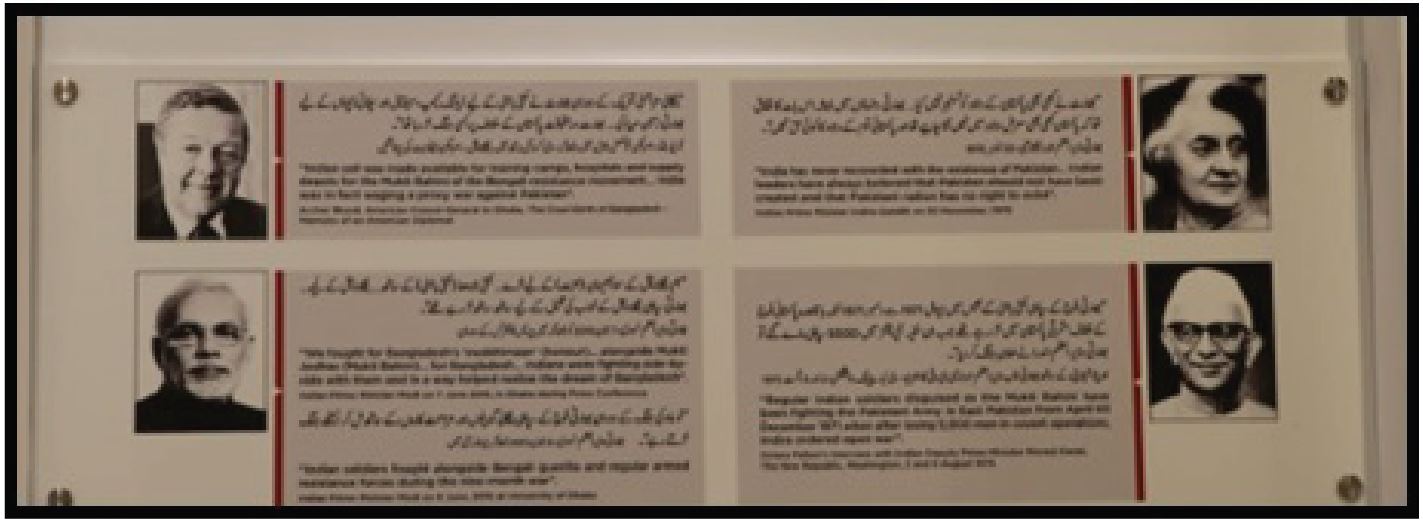
Statements of India and International Leadership
“We fought for Bangladesh's swabhimaan (honor) alongside Mukti Jodhas (Mukti Bahini) for Bangladesh. Indians were fighting side-by-side with them and in a way helped realise the dream of Bangladesh".
–Indian Prime Minister Modi, June 7, 2015,
Press Conference in Dhaka, Bangladesh.
"Indian soldiers fought alongside Bengali guerilla and regular armed resistance forces during the nine-month war".
–Indian Prime Minister Modi, June 8, 2015,
University of Dhaka, Bangladesh.
"Regular Indian soldiers disguised as the Mukti Bahini have been fighting the Pakistani Army in East Pakistan from April till December 1971 when after losing 5,000 men in covert operations, Indira ordered open war".
–Oriana Fallaci's interview with Indian Deputy Prime Minister Morarji Desai,
The New Republic, Washington, 2 and 9 August 1975.
"Indian soil was made available for training camps, hospitals and supply depots for the Mukti Bahini of the Bengali resistance movement. India was in fact waging a proxy war against Pakistan".
–Archer Blood, American Consul-General to Dhaka,
The Cruel Birth of Bangladesh: Memoirs of an American Diplomat.
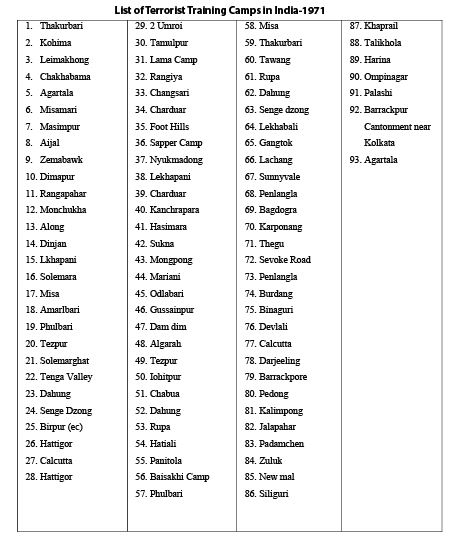
"India has never reconciled with the existence of Pakistan... Indian leaders have always believed that Pakistan should not have been created and that Pakistani nation has no right to exist".
–Indian Prime Minister, Indira Gandhi,
November 30, 1970.
The writer holds a Master’s degree in English Literature and a Ph.D. in Education Administration.
Note: Ironically, Commander of Delta Sector, Debtamura, Tripura, India; Brigadier Shah Beg Singh* (Later Major General) was killed by Indian Army on June 6, 1984 in “Operation Blue Star”.
Ahmad, J. (2016). Creation of Bangladesh: Myths Exploded. AJA Publishers, NMC Enterprise.
Aziz, Q. (1974). Blood and Tears. United press of Pakistan Ltd, Newsweek, 1972, New York.
Blood, Archer (2002). The Cruel Birth of Bangladesh: Memoirs of an American Diplomat. University Press Limited.
Bose, Sarmila. (2011). Dead Reckoning: Memories of the 1971 Bangladesh War. C. Hurst and CO publishers.
Chowdhury, A. M. (1996). Behind the Myth of Three Million. Al-Hilal Publishers Limited, London.
Jacob, J. F. R. (2011). An Odyssey in War and Peace: An Autobiography. Roli Books.
Wahab, A. (2004). Mukti Bahini Wins Victory, Military Oligarchy Divides Pakistan in 1971. Pan Pacific Venture.

 www.hilal.gov.pk
www.hilal.gov.pk
The war of 1965 effected a change in India’s Pakistan strategy, which essentially evolved around a three-pronged offensive on ideological, economic, and military fronts. When the strategy did not succeed, Indian Government resorted to state sponsoring of terrorism inside East Pakistan through the creation of various terrorist organisations like MuktiBahini etc., and infiltrating the political set up in order to exploit the internal socio-political weaknesses. As these efforts also could not deliver the desired results, in April 1971, Indian Prime Minister Indira Gandhi ordered Indian Army to launch an attack on East Pakistan. General Manekshaw, Indian Army Chief; however, convinced her to delay the Indian offensive. According to him, Indian Army was not ready for the offensive and needed time for preparation. Thus, 8-9 months were available to Indian Army to prepare for war and her intelligence organisations had more time to massively enhance state sponsoring of terrorism and furthering the efforts to exploit the internal fissures in support of the impending attack on East Pakistan.
Through a planned and concerted effort, India was thus able to further exploit the internal fissures and managed to generate an extremely negative socio-political environment, which also exacerbated the existing internal weaknesses. After almost nine months of preparations, on December 3, 1971, Indian Government declared an open war against Pakistan and launched its army, navy and, air force offensive in East Pakistan. Simultaneously, war also started on the West Pakistan borders. On December 4, 1971, Pakistan’s Deputy Prime Minister designate and Minister for Foreign Affairs, Mr. Zulfiqar Ali Bhutto, tried to present Pakistan’s case against India in the United Nations Security Council, but having failed to elicit any support, tore the Polish Resolution and boycotted the session.
In such an international environment and having been stripped completely off its supplies, communications and other material resources, a handful of Pakistan Army’s daring, selfless, and determined officers and men continued their endeavours in the defense of their country.
During and after the war, a vicious propaganda campaign was initiated against the Pakistan Army in which it was falsely accused of committing atrocities against the local population. Amongst other aspects, deliberate efforts were undertaken to hide the atrocities committed by Indian Army and various Indian sponsored terrorist groups including Mukti Bahini. These malicious claims have since been proven wrong by various scholars of international repute as well as local Bengali scholars themselves.
In a similar context, a figure of 93,000 Prisoners of War was concocted simply to defame and demoralize Pakistan Army. The total strength of the Pakistani prisoners in Indian camps was not more than 40,000. In this, about 30,000 to 32,000 belonged to Pakistan Army, about 5,000-6,000 were from the Civil Armed Forces, i.e., three Scouts and four Rangers wings, two Mujahid battalions, a small number of Air Force, Naval and Police elements, and a very few civilians.

Map of Location of Terrorist Training Camps in India
1971 War Gallery, Army Museum Lahore
1971 is the most complicated and baffling event of our war history. The war was fought in pockets, having many angles and truths to it. In the 1971 War Gallery’s thematic display, it is represented by angular volumes, jarring shapes, and overcast shadows symbolising times of political confusion, crossroads, and overwhelming pressures.
We decided to highlight the terrorism sponsored by India as a state, therefore extensive research was carried out by Brigadier Sufyan, me, and Syeda Aamna Nadeem. We went through a large number of books written by Indian and Bengali authors, especially the retired officers. With the help of information and data gathered from these books, we were able to create two maps:
▪ Map of location of terrorist training camps in India.
▪ Cities where pro-Pakistani non-Bengalis were massacred in 1971.
Perpetration of India’s state-sponsored terrorism during 1971 in East Pakistan through the application of her defense forces and intelligence agencies is a well recorded historical fact. To sponsor state terrorism, a Control Headquarters was raised in Indian Army’s Eastern Command at Calcutta under the supervision of an Indian Army Major General. Six training centers/sectors were established, each commanded by a Brigadier from Indian Army, to organize, train and equip the terrorists for perpetration of acts of terror in East Pakistan.


Each sector was organized into a number of terrorist training camps, comprising 500 men battalions. Over 100 such terrorist training camps were established where a total of over 100,000 terrorists were trained.
Around 800 officers were trained at regular Indian Army training institutions including Indian Military Academy, Dehradun. At Cochin and Plassey, over 600 terrorists were also given training to carryout terrorist activities at various ports in East Pakistan.
In the majority of cases, serving Indian Army officers accompanied the terrorists in civilian clothes inside East Pakistan and carried out acts of terrorism which resulted in deaths of tens of thousands of innocent men, women and children.
Cities where Pro-Pakistani, Non-Bengalis were Massacred in 1971
The massacre of non-Bengalis, especially pro-Pakistani non-Bengalis by Mukti Bahini terrorists has been mentioned on a map. This map shows the cities where the genocide took place. References about the role played by India, statements of internationally
renowned writers, Bengali scholars, and Indian leaders have also been displayed.

“The Army authorities in East Pakistan have never claimed that their efforts to quell the secessionists was an easy task. Nor have they ever said that during their drive to save the integrity of Pakistan, no innocent civilians, were killed in the cross fire. But, the claim of wanton killing by the army, far less the allegation of systematic genocide by them, is simply untenable”.
–Dr. Abdul Mu’min Chowdhury,
Behind the Myth of Three Million
"The Pakistan soldiers in the East during 1971 was suppressing a rebellion, and not in occupation of a foreign country. Sheikh Mujib's wild figure of three million Bengalis killed during those ten terrible months is at least 20 times too high, if not 50 or 60. And what of all the killing that the Bengalis did whenever they had a chance?"
–Peter Gill, Pakistan Holds Together,
Daily Telegraph, London, April 16, 1973.

“As the Chairman of an official Committee for the relief and rehabilitation of war-displaced persons from East Pakistan in the Orangi Township in Karachi, I met many hundreds of non-Bengali repatriates–men, women, and children. Their evidence gave me the impression that the non-Bengali death toll in the murderous period of March-April 1971 was in the vicinity of 500,000”.
–Qutubuddin Aziz,
Blood and Tears.
“…as a frenzied, shouting mob of 5,000 Bengalis screamed encouragement, young Mukti Bahini guerrillas methodically tortured four suspected Pakistani quislings. For 30 minutes, the guerrillas battered the bound bodies of the helpless prisoners with kicks and karate blows with the bayonets. Quietly and systematically, they began stabbing their victims over and over again all the time carefully avoiding the prisoners' hearts. After more than ten minutes of stabbing, the grisly performance seemed at an end. The soldiers wiped the blood from their bayonets and begun to depart. But before they left the scene, a small boy–perhaps a relative of one of the victims–flung himself on the ground next to a prisoners’ near lifeless body. In an instant, the guerrillas were back, kicking the boy and beating him with their rifle butts. And as he writhed, the child was trampled to death by the surging crowd. This horrendous bloodletting took place next to Dhaka stadium. The man who ordered the public killing and personally saw the order being carried out is Abdul Kader Siddiqui, the Mukti Bahini commander from Tangail”.
–Newsweek, New York,
January 3, 1972
During her interview with Sheikh Mujibur Rahman, Oriana Fallaci, the Italian journalist, wanted to know what the Bangladesh leader thought of this massacre. The following conversation took place between Mujib and Fallaci:
Mujib: Massacre? What massacre?
Fallaci: The one committed by the Mukti Bahini at the Dhaka stadium.
Mujib: There has never been a massacre at the Dhaka stadium. You are lying.
Fallaci: Mr. Prime Minister, I am not a liar. I saw the massacre with other journalists and 15,000 persons. If you'd like, I will show you photographs. My paper has published them.
Mujib: Liar, they were not Mukti Bahini.
Fallaci: Mr. Prime Minister, please do not repeat the word liar, they were Mukti Bahini and they were led by Abdul Kader Siddiqui and were in uniforms.
Mujib: Then it means that those were Razakars that had opposed resistance and Siddiqui was compelled to eliminate them.
–L'Europeo, Rome, February 24, 1972.

Statements of India and International Leadership
“We fought for Bangladesh's swabhimaan (honor) alongside Mukti Jodhas (Mukti Bahini) for Bangladesh. Indians were fighting side-by-side with them and in a way helped realise the dream of Bangladesh".
–Indian Prime Minister Modi, June 7, 2015,
Press Conference in Dhaka, Bangladesh.
"Indian soldiers fought alongside Bengali guerilla and regular armed resistance forces during the nine-month war".
–Indian Prime Minister Modi, June 8, 2015,
University of Dhaka, Bangladesh.
"Regular Indian soldiers disguised as the Mukti Bahini have been fighting the Pakistani Army in East Pakistan from April till December 1971 when after losing 5,000 men in covert operations, Indira ordered open war".
–Oriana Fallaci's interview with Indian Deputy Prime Minister Morarji Desai,
The New Republic, Washington, 2 and 9 August 1975.
"Indian soil was made available for training camps, hospitals and supply depots for the Mukti Bahini of the Bengali resistance movement. India was in fact waging a proxy war against Pakistan".
–Archer Blood, American Consul-General to Dhaka,
The Cruel Birth of Bangladesh: Memoirs of an American Diplomat.

"India has never reconciled with the existence of Pakistan... Indian leaders have always believed that Pakistan should not have been created and that Pakistani nation has no right to exist".
–Indian Prime Minister, Indira Gandhi,
November 30, 1970.
The writer holds a Master’s degree in English Literature and a Ph.D. in Education Administration.
Note: Ironically, Commander of Delta Sector, Debtamura, Tripura, India; Brigadier Shah Beg Singh* (Later Major General) was killed by Indian Army on June 6, 1984 in “Operation Blue Star”.
Ahmad, J. (2016). Creation of Bangladesh: Myths Exploded. AJA Publishers, NMC Enterprise.
Aziz, Q. (1974). Blood and Tears. United press of Pakistan Ltd, Newsweek, 1972, New York.
Blood, Archer (2002). The Cruel Birth of Bangladesh: Memoirs of an American Diplomat. University Press Limited.
Bose, Sarmila. (2011). Dead Reckoning: Memories of the 1971 Bangladesh War. C. Hurst and CO publishers.
Chowdhury, A. M. (1996). Behind the Myth of Three Million. Al-Hilal Publishers Limited, London.
Jacob, J. F. R. (2011). An Odyssey in War and Peace: An Autobiography. Roli Books.
Wahab, A. (2004). Mukti Bahini Wins Victory, Military Oligarchy Divides Pakistan in 1971. Pan Pacific Venture.

India’s State-sponsored Terrorism
The events that unfolded in the 1971 War are largely propagated negatively against Pakistan Army, leaving out the Indian involvement and Mukti Bahini atrocities. This piece sheds light on how Indian state-sponsored terrorism played a role in East Pakistan’s dismemberment. The war of 1965...







